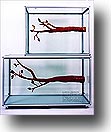Fundación Telefónica,
Mar 10, 2004 - Jun 06, 2004
Santiago , Chile
The End of the Eclipse
by Isidora Correa
Artists:
INSTALLATIONS: Fabiana Barreda, Jorge Macchi, Liliana Porter, Pablo Reinoso, Augusto Zanela (Argentina), José Damasceno, Eduardo Kac, Cildo Meireles, Ernesto Neto, Rosângela Rennó, Tunga, Adriana Varejão, (Brazil), Alfredo Jaar (Chile), María Fernanda Cardoso, Nadín Ospina (Colombia), Carlos Garaicoa, Ernesto Leal, Marta María Pérez Bravo, (Cuba), Gustavo Artigas, Abraham Cruzvillegas, Yolanda Gutiérrez, César Martínez, Pablo Vargas Lugo, (Mexico), Luis Camnitzer, Ignacio Iturria (Uruguay) and Meyer Vaisman (Venezuela). VIDEO ART: Mariano Cohnm, Gastón Duprat, Adrián de la Rosa, Rubén Guzmán (Argentina) Eder Santos (Brazil) Verena Grimm, Yoshua Okón (Mexico) Rafael Besaccia de la Puente, Angie Bonino, Iván Lozano (Peru), Martín Sastre (Uruguay) ART FOR THE NETWORK: Gustavo Romano (Argentina), Giselle Beiguelman (Brazil), Arcángel Constantini, Minerva Cuevas (Mexico) Brian Mackern (Uruguay) The End of the Eclipse exhibition, under the curatorship of the Spaniard José Jiménez, endeavors to shed new light on the perception of art from Latin America at the beginning of the twenty-first century. By means of the show's title, Jiménez brings us a restatement and relocates our perceptions obstructed by supposedly already outdated discussions on what has been considered typically Latin American. Radical and emphatic, the discourse begins by stating that Latin American Art in its supposed unity could not exist and that previous efforts at denomination have limited its possible extension. Thus, during the twentieth century the phrase "Latin American" tended to reduce its coverage to the well-known phrases and stereotypes of "the magical", "the exotic" and "the peripheral", continuing a long tradition based on distance. Now, by means of this exhibition, Jiménez endeavors to redirect this "disturbed" and "eclipsed" vision in an attempt to approximate it more directly to actual fact. Consequently this new vision would be principally defined by the new historical and political circumstances of Latin America, allowing its terms to be expanded. But, what will this expansion actually be? Jiménez will, without a doubt, distance himself from a globalized perspective since, quoting the Cuban writer and essayist Lezama Lima, he is searching rather for an image of ethnic and cultural interweaving by means of the "incorporative voracity" so characteristic of American cultures, in which the "interbreeding of the difference" will be the distinctive trait. Multiplicity is thus emphasized by the curator, when forming a redefinition which transforms the usual denomination of "Latin American Art" into "Art of the Americas."
|











